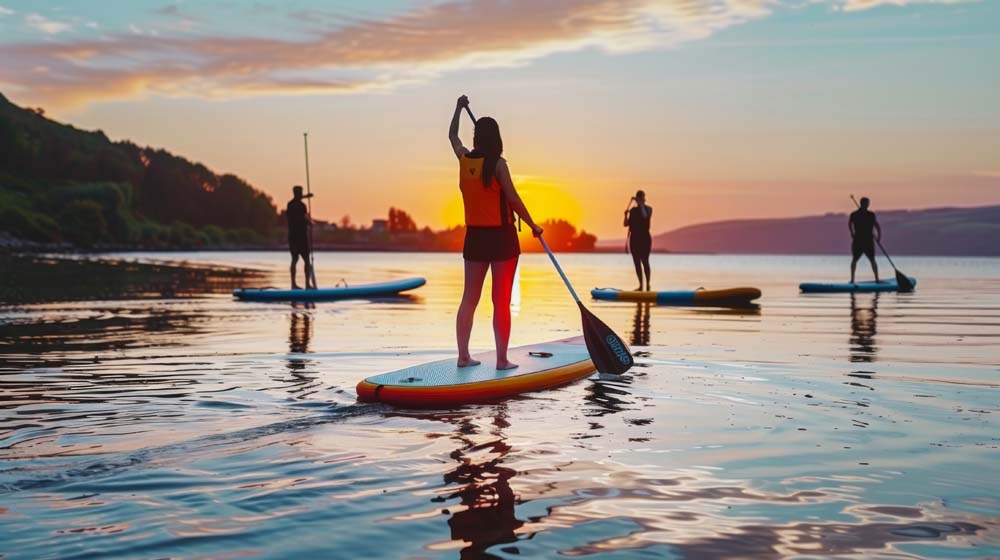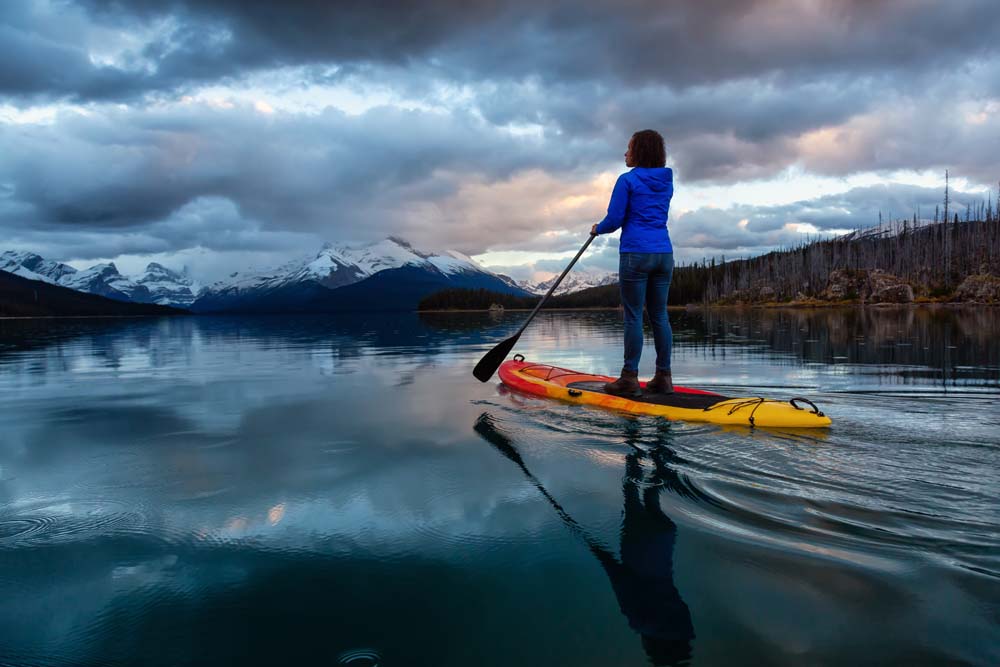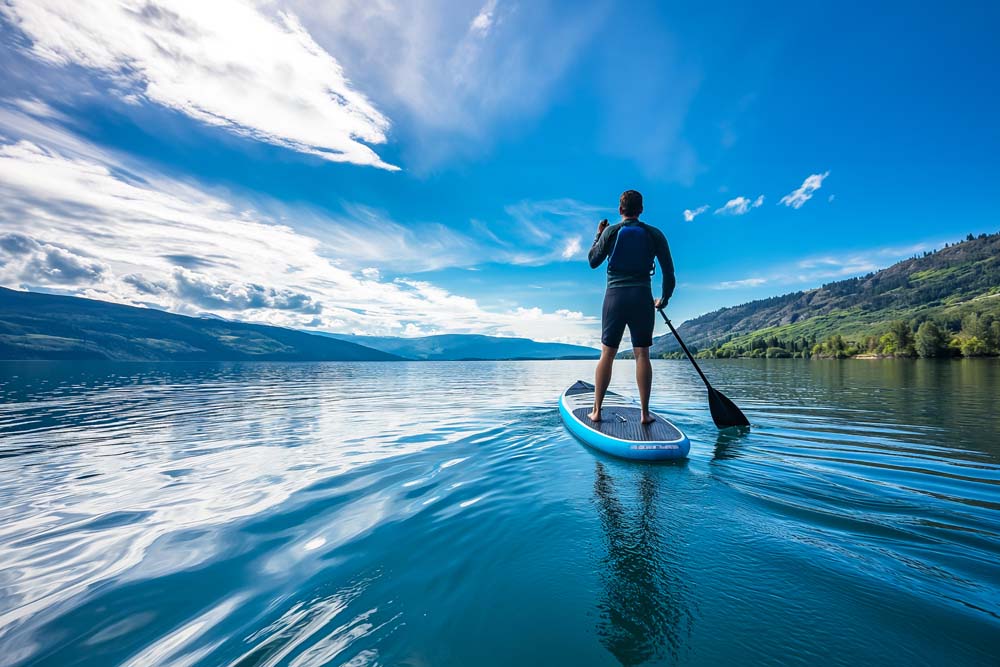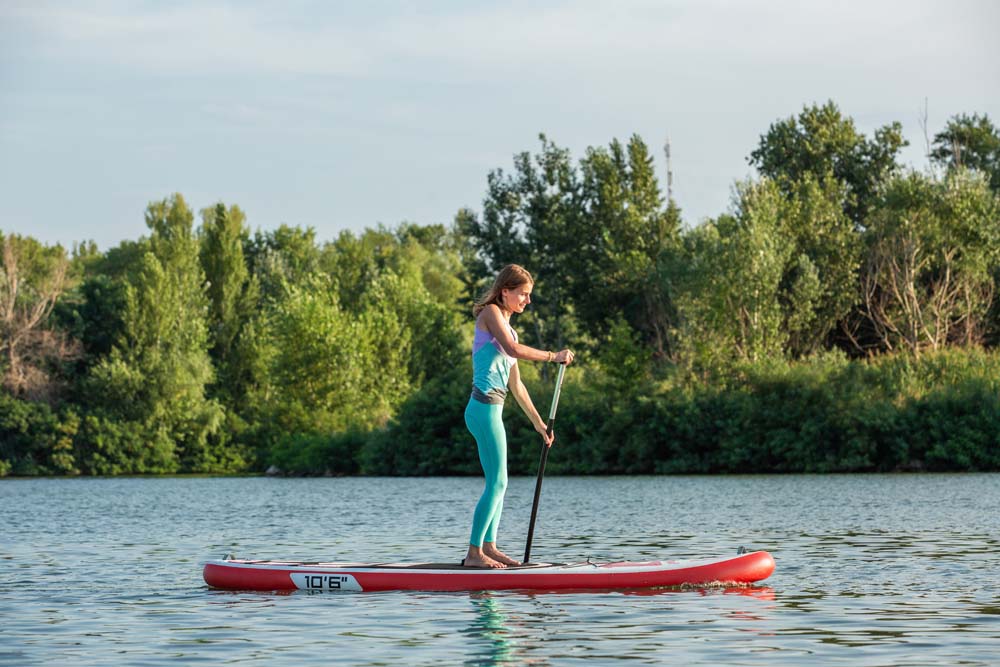If you’re anything like me, you probably jumped into paddle boarding headfirst, thinking it was just a matter of grabbing a board and hitting the water.
But as anyone who’s been out on a windy lake in the wrong outfit can tell you, what you wear can make or break your paddle boarding experience!
Believe it or not, about 70% of paddle boarders say that having the right gear is crucial for a comfortable day on the water.
And it’s not just about looking the part—though let’s be honest, we all want to look good in those Insta-worthy SUP photos!
The real trick is balancing comfort, safety, and style. You want to wear something that keeps you cool when it’s hot, warm when it’s not, and dry when you inevitably take a spill, like a swimsuit or a rash guard.
And with paddle boarding being such a versatile sport—whether you’re paddling in the summer, braving the winter chill, or enjoying a calm spring day—your wardrobe needs to be just as adaptable.
So, what should you wear when you’re getting ready for a day of stand-up paddle boarding?
Let’s dive into the essential gear and clothing that will keep you smiling from your first paddle stroke to your last. Trust me, with the right outfit, you’ll be ready for whatever the water throws your way!
Paddle Boarding in the Summer: Stay Cool and Stylish

When the sun is shining and the water is calling, you want to dress for both comfort and protection.
The right outfit, including a sun hat and a rash guard, can make all the difference in enjoying your time out on the water.
For the best experience on the water, consider packing a dry bag for your essentials and a whistle for safety. the best experience on the water, consider packing a dry bag for your essentials. paddle boarding in the summer, it’s all about finding that sweet spot between staying cool and shielding yourself from the sun.
Opt for lightweight, quick-drying tops and bottoms that keep you comfortable even on the hottest days.
Materials like polyester and nylon are your best friends here—they dry fast and wick away sweat.
Personally, I love a good rash guard for summer paddling.
It’s not just about looking like a pro; it’s about protecting your skin from those sneaky UV rays.
A long-sleeve rash guard is perfect because it offers extra coverage while keeping you cool, and it helps protect against getting wet from splashes.
Plus, it prevents chafing from your paddle, which is a game-changer for those long days on the water.
If you prefer short sleeves, that’s cool too—just make sure to slather on the sunscreen!
When it comes to bottoms, board shorts are a classic choice for a reason.
They’re comfortable, versatile, and dry quickly after a dip in the water.
For a bit more coverage, consider lightweight water leggings that protect your legs from the sun and any unexpected scrapes.
Whatever you choose to wear, make sure it’s something that makes you feel comfortable and confident.
Remember, the most important thing to wear is a smile—because that’s what really makes your Your SUP adventure will be more enjoyable if you wear a bathing suit underneath your gear for comfort.
Unforgettable!
Paddle Boarding in the Winter: Layer Up or Chill Out

Winter paddleboarding can be a magical experience, but it definitely requires a bit more preparation to stay warm.
The crisp air, the serene waters, and the chance to have the whole lake to yourself are worth it.
But trust me, you don’t want to be caught shivering out there without the right gear.
To make the most of winter paddling, you’ll need to wear paddle boarding gear that insulates and protects you from the cold.
A wetsuit A drysuit is a must-have for paddleboarding in varying weather conditions. Paddleboarding in the winter requires a drysuit to handle the cold water temperature., especially if you’re paddling in colder waters.
A wetsuit is great for keeping your body heat in, using a thin layer of water between your skin and the suit to act as insulation.
It’s like wearing a cozy blanket that lets you move freely—perfect for mild winter days.
But if you’re facing seriously chilly conditions, a drysuit is your best friend.
Drysuits keep you completely dry and allow you to layer up underneath with warm, thermal clothing.
This means you can customize your layers depending on how cold it is outside.
Speaking of layers, don’t forget to start with a good thermal base layer.
These snug-fitting garments trap body heat and wick away moisture, keeping you warm and dry.
Over your base layer, add a fleece or wool mid-layer for extra insulation.
And, of course, a waterproof top layer is essential to keep the wind and water out.
For your feet, neoprene booties are great for keeping those toes warm in cold water.
And don’t forget about your hands—a pair of neoprene gloves can make a big difference on a frosty day.
Winter SUP Paddle boarding might sound a bit daunting, but with the right gear, including a life jacket, it can be one of the most rewarding paddle boarding experiences.
So, layer up, stay warm, and get ready to enjoy the quiet beauty of stand up paddle boarding in the winter.
Spring SUP Style: What to Wear While Paddle Boarding in Spring

Spring can be one of the best times for paddle boarding, but it can also be a bit unpredictable.
One minute it’s sunny and warm, and the next, you’re paddling through a chilly breeze or a sudden downpour.
That’s why it’s important to be prepared for any weather when you’re heading out for some spring SUP.
The key to dressing for paddle boarding is to consider wearing board shorts that allow for flexibility and comfort. paddle boarding in spring is layering.
Start with a lightweight, moisture-wicking base layer that keeps you comfortable if the temperatures rise.
On top of that, add an insulating layer, like a fleece or thermal shirt, to keep you warm during those cooler moments.
A light neoprene jacket or vest is perfect for those crisp spring mornings when you need a bit more warmth.
It provides some insulation and protects against wind, but won’t make you overheat if the sun decides to make an appearance.
If you’re planning on spending the whole day on the water, you might want to bring a spare change of clothes just in case.
And remember, paddle boarding in spring often means you might encounter a few unexpected showers.
A waterproof layer, like a rain jacket or a windbreaker, is a smart addition to your gear.
It’s lightweight enough to carry in your bag and can be a lifesaver when the weather takes a turn.
Don’t forget to protect your hands and feet as well—neoprene gloves and water shoes can keep you warm without weighing you down.
And always keep an eye on the forecast, but be ready for surprises—because spring loves to keep us on our toes!
With the right gear, you’ll be ready to embrace all the joys of stand up paddle boarding in the spring, rain or shine.
What to Wear When Paddle Boarding: The Essentials

The right clothing can make all the difference when you wear paddle boarding.
It’s not just about looking good—it’s about staying comfortable, safe, and ready for whatever the water throws at you.
For stand up paddle boarding, it’s important to choose gear that’s comfortable, functional, and appropriate for the weather.
You want to be able to move freely, stay protected from the elements, and keep your temperature just right; wearing a hat can also help shield you from the sun.
If you’re out on a hot, sunny day, lightweight, breathable fabrics are a must to keep you cool, along with bare feet for comfort on the paddleboard.
On colder days, layers are key—you can always peel off a jacket or add a thermal top as needed.
Whether you’re doing SUP yoga or cruising down a river, make sure you have the right attire for the activity.
For yoga on your SUP, stretchy leggings and a form-fitting top will keep you flexible and prevent wardrobe malfunctions.
River SUP might call for a bit more coverage, like board shorts and a rash guard, to protect against scrapes from rocks or branches.
Some people might think it’s okay to wear normal clothes on the water, but trust me, that’s a rookie mistake.
You don’t want to be caught in soggy jeans or a heavy cotton shirt if you take a spill.
Out on the water, you’ll need something a bit more specialized—quick-drying, moisture-wicking, and built for action.
And let’s not forget the importance of sun protection.
Even on a cloudy day, those UV rays can sneak up on you, so long sleeves, hats, and sunscreen are your best friends.
When it comes to footwear, decide based on where you’re paddling.
Barefoot is great for some, but wearing neoprene shoes can provide better grip and protection while paddle boarding. calm waters and SUP yoga, but water shoes or booties are better for rocky or cold conditions.
So before you hit the water, take a minute to think about what you’re wearing.
Your outfit can make or break your day on the paddle board, so choose wisely!
After all, the goal is to enjoy every moment on your SUP adventure, and the right gear will help you do just that.
Sun Protection: The Must-Have Accessory for Paddle Boarding
Sun protection is a must when you’re out on the water for extended periods.
The sun’s rays can be deceptively strong, especially when they reflect off the water and catch you off guard.
That’s why it’s so important to wear paddle boarding gear that keeps you covered and protected from the sun.
Start with a wide-brimmed hat to shield your face, ears, and neck from direct sunlight.
A baseball cap can work too, but make sure it has a neck flap or you’ll be constantly turning to avoid a burnt neck!
And don’t forget your sunglasses—ideally with a strap so they don’t end up at the bottom of the lake.
Look for sunglasses with polarized lenses to reduce glare and protect your eyes from harmful UV rays.
Sunscreen is another absolute essential.
Apply a good layer of broad-spectrum sunscreen with at least SPF 30 to all exposed skin.
Don’t forget spots like the tops of your feet, the back of your neck, and your ears, which are easy to miss but quick to burn.
A long-sleeve rash guard or UV-protective shirt is a great addition to your guide on what to wear for a paddleboard adventure.
These shirts are made from lightweight, breathable fabrics that keep you cool while offering sun protection.
They’re especially useful if you’re paddling for several hours or in the middle of the day when the sun is at its peak.
Even if you’re not paddling in tropical waters, remember that the sun’s reflection off the water can still give you a surprising sunburn!
So, it’s better to be over-prepared than under-protected when it comes to sun safety.
Investing in the right sun protection gear is not just about comfort—it’s about safeguarding your skin and your overall health.
Trust me, no one wants to end a perfect day on the water with a painful sunburn.
So, before you head out, double-check that you’ve got all your sun protection gear ready to go.
Your future, sunburn-free self will thank you for it!
The PFD Debate: Why It’s an Important Thing to Wear While Paddle Boarding

Safety first, folks!
A PFD (personal flotation device) is a must for everyone, from beginners to pros.
No matter how experienced you are at paddleboarding, accidents can happen when you least expect them.
Whether you’re paddling on a calm lake, navigating choppy seas, or tackling a river SUP, a PFD is essential.
Think of it as your insurance policy against unexpected swims, slips, or spills.
It’s not just an important thing to wear—it’s also required by law in many places!
A PFD provides crucial buoyancy that can keep you afloat if you end up in the water.
Even the best swimmers can get tired or disoriented, especially in rough conditions or cold water.
Wearing a PFD gives you peace of mind, knowing that you’re prepared for anything the water might throw at you.
There are different types of PFDs to choose from, so you can find one that suits your style and comfort.
Some paddlers prefer a traditional vest-style PFD, which provides maximum buoyancy and a snug fit.
Others opt for an inflatable PFD that’s more lightweight and less bulky, which can be a great choice for warm-weather paddling.
The key is to find a PFD that you’re comfortable wearing for extended periods and that doesn’t restrict your movement.
It should fit well, be adjustable, and stay securely in place while you’re paddling.
And remember, a PFD isn’t just for emergencies—it’s a constant reminder to practice safe paddleboarding habits.
It encourages you to stay mindful of your surroundings, check the weather and water conditions, and always paddle within your limits.
So, don’t skip the PFD just because you’re paddling close to shore or in shallow waters.
You never know when a surprise wave or a sudden change in conditions might catch you off guard.
Wearing a PFD is one of the simplest and most effective ways to protect yourself while enjoying your stand up paddle boarding adventures.
Stay safe, be smart, and always put safety first—you’ll have more fun knowing you’re prepared for anything!
Don’t compromise on safety! Explore our top picks for the best life jackets of 2024 to keep you secure while paddle boarding.
To Footwear or Not to Footwear: What to Wear on Your Feet When Paddleboarding
The choice of whether to go barefoot or wear water shoes is a personal one.
Some paddlers love the feeling of the board under their feet and prefer to paddle barefoot.
Barefoot is great for SUP yoga and casual paddling on smooth, sandy beaches or calm lakes.
It allows you to feel more connected to your board and can help with balance and stability.
There’s something freeing about paddling barefoot, with the water splashing over your toes as you glide along.
However, if you’re venturing into rocky areas, reefs, or places with sharp shells, going barefoot might not be the best idea.
In these situations, water shoes or booties can provide protection and keep your feet safe from cuts and scrapes.
Water shoes are also great for cold waters, as they offer a layer of insulation to keep your feet warm.
Neoprene booties, in particular, are a popular choice for paddling in colder conditions or during the winter months.
They’re designed to be snug and flexible, allowing you to maintain good contact with the board while keeping your feet toasty.
When choosing footwear for paddleboarding, make sure whatever you wear has a good grip on the board.
The last thing you want is to slip and slide around on your SUP because your shoes don’t have enough traction!
Look for water shoes or booties with rubber soles that are designed for water sports.
These will give you the grip you need while still being lightweight and easy to wear.
It’s also important to choose footwear that fits well and won’t slip off easily if you take an unexpected swim.
Adjustable straps or snug-fitting booties can help keep your shoes in place, even in rough water.
Ultimately, the decision to go barefoot or wear shoes comes down to personal preference and the conditions you’re paddling in.
If you’re unsure, it’s always a good idea to bring a pair of water shoes along just in case.
That way, you can start barefoot and slip them on if you encounter rough terrain or cold water.
Whatever you decide, the most important thing is to feel comfortable and confident on your board, so consider wearing a rash guard for added protection.
Happy feet make for a happy paddler, so choose neoprene shoes that work best for you and your comfort on the board. stand up paddle boarding adventures!
Conclusion on What to Wear Paddle Boarding
Paddle boarding is a fantastic way to enjoy the water, but what you wear can make a big difference.
Having the right gear means you can focus on the fun and excitement of being out on the water.
By choosing the right clothing and accessories, you’ll stay comfortable, safe, and stylish.
It’s all about finding that perfect balance between functionality and fun.
Whether you’re paddling in the summer sun, braving the winter chill, or navigating the unpredictable spring weather, there’s an outfit for every adventure.
So grab your gear, dress appropriately, and get ready to paddle in style!
Don’t forget to layer up in the winter, protect yourself from the sun, and always wear a PFD for safety.
And when it comes to footwear, make sure you choose something that suits your paddling environment and personal preference.
But above all, remember that paddle boarding is about having fun and enjoying the freedom of the open water.
So, don’t stress too much about what to wear—just make sure you’re comfortable and ready for anything.
Because at the end of the day, the most important thing is to have fun and enjoy every moment on the water.
So, get out there, embrace the adventure, and make some unforgettable memories on your paddle board!
Ready to upgrade your SUP experience? Explore the ultimate guide to the best paddle board accessories and discover the must-haves that will make every paddle more exciting!


0 Comments